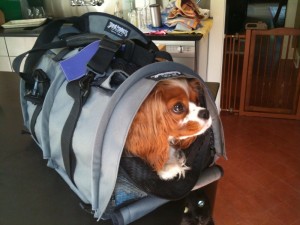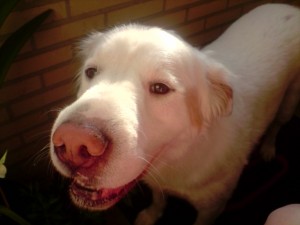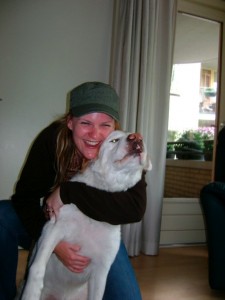Welcome to AndASmallDog.com - the site dedicated to providing accurate travel advice and information for you and your dog! I am a travel agent who specializes in pet travel. Have a look around and let me know if I can be of any assistance with your next trip!
We are pleased to announce that AndASmallDog.com and our campaign, GiveBigDogsABreak.com, have been included in an article in the newest issue of Fido Friendly (in stores now!). 
Read it online or pick up a copy from your local bookstore!
Thank you Fido Friendly!
{ 0 comments }
This is a guest post from Mary-Alice Pomputius, who has two blogs. Dog Jaunt offers advice about traveling with a small dog and Pet Carrier Reviews offers unbiased reviews of carriers and crates for dogs, cats and other pets. AndASmall Dog loves reading Dog Jaunt – always something new and informative!
I write about all aspects of traveling with a small dog (our dog, Chloe, is a young Cavalier King Charles Spaniel), but most of the questions I get are about taking a small dog on a plane. And most of those questions are about choosing a carrier. It’s a bewildering task: There are lots of choices, and there are lots of parameters to worry about. Nearly all of the U.S. airlines allow small dogs to travel in-cabin, and many international airlines do too, but there is no standard accepted maximum carrier size. Take a look at the “Guides” section on my blog, Dog Jaunt, and you’ll see that the maximums range from extremely small (Sun Country’s 8Hx16Lx11W) to the relatively palatial (THAI Air’s 12Hv22Lx15W). What’s a dog owner to do?
Here are five tips:
1. Assess your dog
The very first thing you need to do is measure your dog’s height. The crucial measurement is the distance from the floor to the top of your dog’s shoulders — not his head, his shoulders. Imagine that your dog has put his head down to drink water. His head and neck have bent low; the remaining body height is what you care about. That’s because your dog will spend nearly all of his time in his carrier lying down, either curled up or stretched out. He needs to be able to turn around freely in his carrier (that’s merciful, and it’s also an airline requirement), but he doesn’t need to raise his head completely to turn around or be comfortable.
That number is the minimum height that your carrier needs to be. If you’re blessed with a mini Dachshund, for example, you’ll likely be able to purchase a carrier with extra vertical room. We, however, have a dog that is 12″ tall, and so is her carrier.
Another crucial measurement is your dog’s weight. In general, a dog that weighs more than 15 lbs. is going to be too large to travel in-cabin. Some airlines have maximum weight requirements (look out, especially, for some very low international maximums), but the main problem is that a dog larger than 15 lbs. may not fit in a workable carrier and still be able to turn around freely. Chloe weighs 13 lbs., and she is at the upper limit of what works.
2. Buy a good-quality carrier
If you plan to take only one plane trip with your dog (say, for example, you hate to travel, but you need to relocate from Houston to Seattle — please note that I’m choosing two cities not serviced by the pet airline Pet Airways, which will carry your dog in-cabin for you), ignore this advice. Buy an inexpensive but complying carrier, like the small Bergan Comfort Carrier (available on Amazon), and call it good.
If you plan to travel frequently with your dog, however, don’t chintz on the carrier. Yes, a good carrier is expensive, but it will be sturdy and have features that contribute to your dog’s comfort and to your peace of mind. The features I look for include sturdy and big/numerous mesh ventilation panels, good-quality zippers, visual access to your dog from above (since your dog will spend most of your journey at your feet), patting access to your dog from above, at least one good-sized pocket, and minimal weight. A bonus feature is the ability to slip the bag over the extended handle of my own suitcase.
The features that airlines require include mesh ventilation panels on at least two sides, water-repellant fabric, padding, the ability to completely contain your dog, and sufficient room for your dog to turn around.
My choices? Chloe’s go-to carrier, the one she uses for her longest trips, is her large SturdiBag. My other favorite, and the one I use when I suspect that under-seat space is going to be tricky, is her Sleepypod Air carrier. If she weighed 10 lbs. or under, I would use her Creature Leisure Pet Pilot XL carrier (it’s a heavy carrier, though, so I wouldn’t use it if I was concerned about weight maximums). Please note that none of these carriers is a Sherpa bag, which is the original (and still most popular) soft-sided pet carrier. They have many good qualities, but their tops are solid, and I insist on being able to see Chloe from above, for both her comfort and mine.
3. Choose a carrier that flexes
The simple fact is that most pet carriers you see in use at an airport are non-complying. Only the tiniest of dogs can fit in a carrier that is 8-9 inches tall. The bag you will see most often, a classic Sherpa bag in size Medium, is 10.5 inches tall. No ticketing agent or gate agent will turn a hair over a medium Sherpa bag, and there is, in practice, a bit of leeway afforded to traveling pet owners. Don’t take it to extremes (a large Sherpa bag is too large, as is an extra-large SturdiBag), because even if you can charm your way past an agent, you still have to fit your dog in an airplane’s under-seat space. Since that space is fairly shallow, your dog’s carrier needs to fit oriented left-to-right. A carrier that is 18 inches long works; 19 inches is iffy; 20 inches is too long.
The three bags I like flex in important ways. The SturdiBag’s top and sides flex considerably, but its length is fixed at 18 inches. The Sleepypod Air can lose about an inch in height, but it is designed to (temporarily) lose up to 6 inches in length. The Creature Leisure Pet Pilot XL flexes in a different way: Zipped up, it just fits under most airplane seats, but as soon as you take off, you can pull it out from under the seat and unzip a large gusset that gives your dog a good deal of travel room during flight.
That last point is an important one to remember. Your dog needs to fit under the seat in front of you for takeoff and landing, but during the rest of the flight you can pull his carrier out into the space under your knees. With that room, the top of the SturdiBag pops back out, the ends of the Sleepypod Air flip back down, and your dog has the maximum scope his carrier allows him.
4. Choose black
Black bags look smaller. If you are the owner of a dog small enough to fit in a fully-complying carrier, buy one that’s neon orange. Live it up! The rest of us need to minimize the visual impact of our pet’s carrier.
5. Consider wheels
If you are traveling far enough that you have a layover, you’ll want to make it a long one, so that you and your dog have the chance to exit the airport, find the pet relief area, and return through security. Some pet relief areas are conveniently located and easy to find, but many are not — and sometimes the gate you arrive at is a remote one. You’ll need to hurry to achieve your goals, and wheels help. Chloe’s a small dog, but by the time I get to the pet relief area in Denver she effectively weighs about 57 lbs.
Only one of my favorite carriers (the Pet Pilot XL) has wheels, and it’s really too small for Chloe. Wheeled carriers that comfortably fit a dog Chloe’s size are typically too big to work as in-cabin carriers, unfortunately, but owners of dogs under 10 lbs. should give wheels serious consideration.
Thank you Mary-Alice for your wonderful and informative post! Please be sure to check out Dog Jaunt and Pet Carrier Reviews for more information.
{ 1 comment }
You may not know this but my dog, Bodie, is an expat pet. We adopted him when we lived in Amsterdam in 2006, when we were the expats living in Holland. We’ve since moved back to Florida, and so its his turn to be the expat (expat is short for “expatriate”).
Bodie isn’t the only expat pet who likes to share his experience of traveling and exploring different countries.
Clogs and Tulips: An American in Holland recently scored an interview with expet Turner Jansen. Turner relocated with his parents to the Netherlands late 2008 and agreed to take the time to answer a few of our questions.
Clogs and Tulips: What brings you to the Netherlands?
Turner Jansen: My daddy is Dutch and after he and my mommy got married, my mommy and I moved to the Netherlands to live with my daddy. Originally, I come from the United States.
CT: What sorts of things needed to be in order for you to come into the Netherlands?
TJ: It was pretty easy, actually. All I needed in for entry into the Netherlands was a microchip or tattoo, a certificate of health from my veterinarian, updated shots, and an airline compliant travel crate. We had the microchip done at a Humane Society clinic, which really kept the price down. My parents opted to do everything themselves as opposed to going through a pet relocation agency. My daddy was on the flight with me and was there to pick me up at the baggage claim. Cheap and easy. One thing we didn’t do before relocation that I would recommend was get me a passport. We were able to get one from my new veterinarian here in the Netherlands with no trouble at all.
CT: What was the most challenging adjustment you had to make coming to the Netherlands?
TJ: The biggest challenge was getting used to all the bicycles. I still find bicycles terrifying. My mommy keeps trying to teach me how to run along side the bike, but they’re just so scary! I always have to be reminded of where the bicycle paths are – they look like sidewalks still to me. A very dangerous mistake when you have a fear of bikes. (AndASmallDog Note: Bodie is also afraid of bicycles – but luckily got in the habit of ignoring them!)
CT: Was it easy to find a good veterinarian, groomer, and pet hotel? Is language an issue?
TJ: My mommy joined the International Women’s Contact Utrecht right away after we moved and was able to ask some of the other members for recommendations. I feel about the vet like I hear most humans feel about the dentist, but luckily, we found a really good one. My mommy communicates with him mostly in Dutch, but he’s able to explain more complex things in English and is more than happy to switch over if my mommy needs it. I’ve had two appointments so far and, although they speak Dutch to my mommy, they speak in English to me, which really helped me relax a little. My vet takes care of my nails and my parents do the rest of my grooming, so finding a groomer wasn’t necessary. Again, the vast majority of the Dutch are very versatile in English, but I would recommend learning as much Dutch as you can.
The first pet hotel I stayed at, my parents found on their own and we didn’t like it at all. The second one we tried was recommended by a friend of my mommy’s from the IWCU and we really love it. They also speak reasonable English.
CT: Can you talk about some of the major differences between the US and the Netherlands?
TJ: Here in the Netherlands there are special dog toilets and dog play areas. There are also designated areas where dogs can run free. These dog areas are cleaned by the city, so you don’t have to worry about cleaning up after your dog (all dog owners pay a dog tax to maintain these areas). What’s really frustrating is the number of people that allow their dogs to relieve themselves in restricted areas – playgrounds, sidewalks, etc – and don’t clean up after them. In the US, I was only allowed into a very limited number of places but, in the Netherlands, I can go almost everywhere: restaurants, cafes, stores. As long as there’s no sign depicting a dog inside a red circle, I’m allowed in.
When my uncle was visiting, my mommy and I went with him into a really fancy men’s clothing store and nobody even noticed that I was there! I can also travel on trains, busses, the metro, and trams… as long as I have a ticket. The best part is that every restaurant has its own cat to keep the mice at bay. I love going out to lunch with my parents and rubbing elbows with the restaurant cats. What I miss most about the US are the large yards that most homes have to run around free in. We try to go to the woods nearby as often as possible so I can run out all of my energy.
CT: Thank you so much for taking the time to talk to us. Are there any last words you have to share with our readers?
TJ: It was my pleasure. What I would say to anyone planning on taking their pet abroad with them is to do whatever you can to make the transition easy on your pet. Let them get used to their travel crate before your departure and make sure there is plenty of water place and familiar items in the crate: a blanket and maybe a soft toy. Set into a routine right away so that your pet knows what to expect. Take your pet around the neighborhood so they can get used to their new surroundings. Have familiar things around your new home like furniture pieces, blankets, rugs, and toys so that not everything is brand new. The Netherlands is a great place to raise a pet!
Tiffany Jansen moved to the Netherlands in December 2008 with dog in tow after marrying a Dutchman. She runs her own company Little Broadway and does some freelance writing on the side. You can read more about her adventures as an American expat in the Netherlands on her blog Clogs and Tulips: An American in Holland.
If anyone is interested in reading more about living abroad, especially in Holland, please do check out Tiffany’s great blog!
Thank you to both Tiffany and Turner for your great insight!
{ 1 comment }




